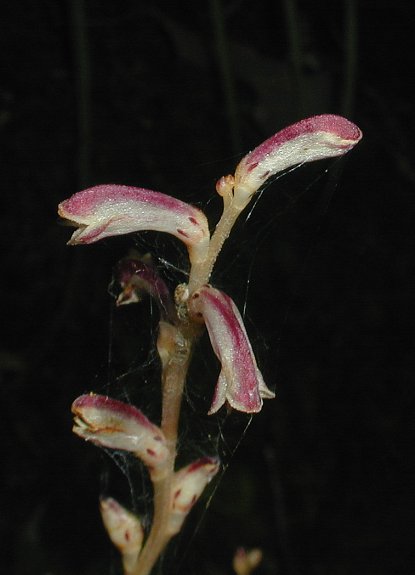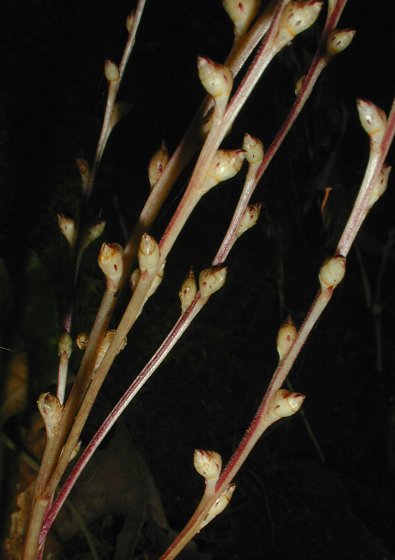Description: This herbaceous parasitic plant is 4-18" tall. Small plants are often unbranched, but large plants are paniculately branched with stiff ascending stems. These stems are initially cream, tan, or purple-striped, but they turn brown with age. The surface of each stem is mostly glabrous, but sometimes it is slightly pubescent. The leaves are reduced to insignificant scales; they are located underneath some of the flowers. Along the length of the stems are alternate flowers; the lower stems have cleistogamous (self-fertile) flowers, while the upper stems have perfect flowers that are usually sterile. The cleistogamous flowers are small and bud-like in shape, while the perfect flowers have tubular corollas with short calyces.

The corolla
of a perfect flower is about 1/3" (8 mm.) in length, cream- and
purple-colored,
with 4 short lobes along its outer rim. Each calyx is cream-colored
with 5 purple-striped teeth; it is much shorter than the corolla of a
perfect flower. Each perfect flower has a single style and four
stamens; the latter are hidden within the corolla. The blooming period
occurs from late summer into the fall. There is no noticeable floral
scent. Each fertile flower is replaced by a small ovoid seed capsule
about ¼" (6 mm.) long; it contains numerous tiny seeds that can be
blown about
by the wind. The root system is fibrous. Sometimes large colonies of
this plant can be found.
Cultivation:
This
parasitic plant contains no chlorophyll and obtains its nutrients from
the roots of Fagus grandifolia (American Beech).
Without the presence of this tree, Beechdrops cannot survive.

Range &
Habitat:
The native Beechdrops is uncommon in Illinois; it is found in a few
counties of
the southern and SE regions of the state (see Distribution
Map). Illinois lies at the western range limit of both
Beechdrops and the American Beech; both species are more common further
to the east. Habitats include mesic woodlands and rocky wooded slopes
where American Beech and Sugar Maple trees are usually codominant.
Faunal Associations:
Very little information is available about floral-faunal relationships
for this species. The perfect flowers may be visited occasionally by
long-tongued bees. The ecological value of Beechdrops to animals
appears to be low.
Photographic Location:
A rocky wooded slope in west central Indiana where American Beech was
present.

Comments: From a distance, this plant looks like it is dead, even when it is in bloom, resembling an elongated skeletal hand that has poked up from the ground. When examined up-close, however, it is an interesting plant with beautiful cream and purple-striped flowers and similarly colored stems. Beechdrops is a member of a small group of parasitic plants in the Broomrape family (Orobanchaceae). None of these species are very common in Illinois, and they should be protected in the areas where they occur. Other species in this family tend to be more stout and less branched than Beechdrops; they also produce larger flowers with similar tubular corollas (exceeding ½" in length). These species don't compete directly with Beechdrops because they are parasitic on the roots of plants other than American Beech; typical hosts are oak trees and various members of the Aster family.